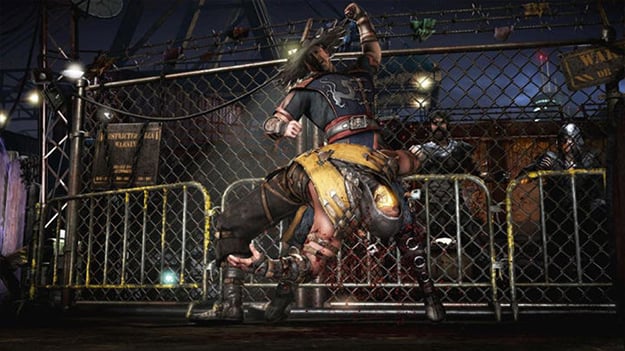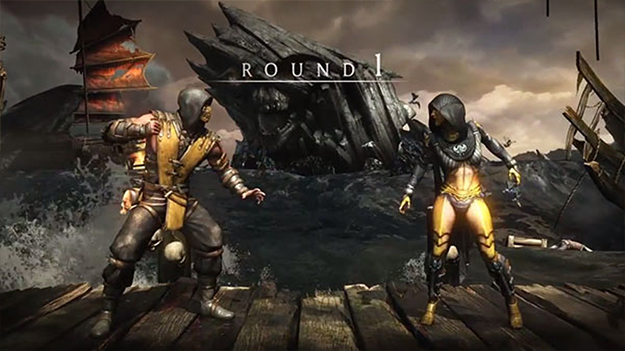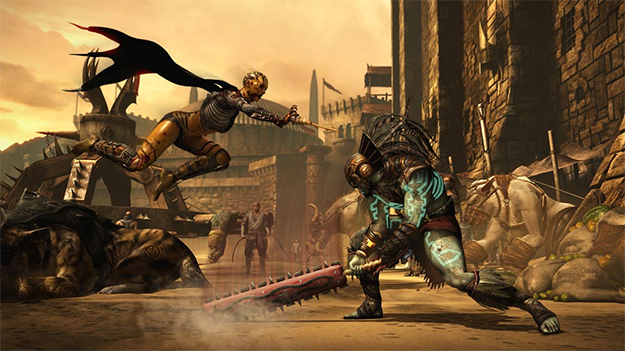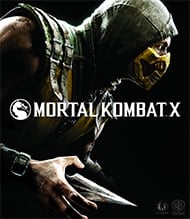7000+ Matchups
Mortal Kombat X is the latest installment in the Mortal Kombat franchise, and arguably only the second to ever try to be taken seriously as a fighting game. It is a direct sequel and evolution of 2011’s Mortal Kombat (called Mortal Kombat 9 in fighting game circles). It melds elements of this prior Mortal Kombat release with elements of the in-between DC Comics fighting game, Injustice: Gods Among Us . It’s also not afraid to try out new systems that we simply haven’t seen in fighting games before. Of course, this willingness to innovate also results in a couple ideas that were probably best left on the cutting room floor, but it also makes Mortal Kombat X a truly unique experience that is very different from the same arcade-style fighting games that we have seen in the past.
As things stand, I have only had a limited amount of time with Mortal Kombat X . We did not receive a review copy of the game before its launch, and the PC version of the game has been fraught with bugs, some even preventing the game from launching. The game’s online servers have not yet been fully activated, and a good portion of the game’s content, such as the Challenge Towers which Netherrealm will change on a regular basis, simply isn’t implemented yet. Not only that, but a massive day one patch is set to change practically everything about the game, making a lot of these impressions obsolete, and that is kind of annoying both for us game journalists and for players who got the game early and already started learning their favorite characters.
But even with the limited amount of experience I have had, I can already tell that Mortal Kombat X is a solid game.
Mortal Kombat X earns its highest marks in presentation. It’s just dripping with personality, almost as much as it’s dripping with blood. Every single pair of characters has distinct pre-match conversations that they can have, fleshing out their character and backstory even before versus matches. The stages feel alive and complex, rather than simply being a painted background for battles to occur on. Character costumes are no longer generic ninja suits and skimpy sex princess outfits, and instead focus on bringing out each character’s individual style, from Erron Black’s cowboy outfit, to Cassie Cage’s spec ops uniform. Even the loading screen has personality, as characters scoff at each other and head to their corners before a match begins.

But nowhere does this personality come through stronger than in the game’s fantastic campaign mode. Usually, fighting games simply ignore single-player modes like this, opting for a simple gauntlet of matches with an interspersed cutscene here or there. At best, we have seen story modes with long interludes of text over still images. But Mortal Kombat X ’s storyline features fully animated, fully voice acted scenes that seamlessly transition into fights. They look even better than Mortal Kombat 9 ’s, and that game won the award for best single-player experience in a fighting game ever.
Not to mention the story of how the world we know it has become overrun with demons and extradimensional baddies after Raiden killed Liu Kang in the last Mortal Kombat game is actually really compelling. The characters are honestly likeable. Series staples like Scorpion and Sub-Zero are no longer simply “blue ninja” and “yellow ninja”, nor are they shallow stereotypes following a quest for vengeance that hasn’t ended since the first Mortal Kombat . They are fully realized characters with motivations, fears, and desires, and this makes them way cooler than they ever were before.

The only problem I find with the game’s single-player mode is how quickly it shuffles you from character to character. You don’t get a choice in who you play, you simply take control of who the story calls for at any given point in time. On one hand, this gives you a nice little taste of most of the characters in the game, which makes choosing your favorite easier. On the other hand, you never really get to know any character well enough in the limited amount of fights you have to really understand how they play. The difficulty also ramps up as the story mode goes on, which means that you may be forced to control a character that you really hate for some of the game’s hardest battles. It also doesn’t really do much to explain the game’s variation system, which is a core component of versus mode battles, and which may make some of your favorite campaign characters control completely different in practical matches.
That being said, the variation system is probably the best thing going for it outside of its presentation. Each character has three different styles to choose from prior to battle. Basic normal and special moves remain the same between each style, but you then get an additional set of special moves and combo strings based on the style you chose. Styles can differ wildly, even going as far as to change a character’s archetype. One style may focus on projectiles, while another focuses on quick strikes, and a third focuses on teleports.
I simply cannot stress what a genius move this is. Subtle variations in normal and special moves have differentiated fighting game characters (like Ryu and Ken) for ages. It doesn’t take much to completely change how the character is played, which means it also doesn’t take much to design these variations in the first place. With three variations per character and a character roster of 29 characters including DLC, that totals to 7569 different matchups. That’s insane! No other fighting game has even come close to this level of depth.
The gameplay of Mortal Kombat X is not without its faults, however. There are still far too many buttons involved, with two punches, two kicks, block, grab, stage interaction, and more each having their own button on the controller. Some commands, like the run command, are needlessly complicated. It feels like there could have been shortcuts or specific button combos to prevent all these buttons from being used, especially when there is still a button devoted to the otherwise useless “change stance” aesthetic change. It’s one of the only fighting games that practically requires a pad instead of a fighting stick, because your fingers simply can’t reach all the buttons at once.
Stage interaction from Injustice: Gods Among Us returns, and while they’re better balanced and less swingy here, they still feel cheap and more interrupt the flow of a match rather than adding interesting elements to a character’s arsenal. Stage interaction is also tied to the new stamina mechanic, which is a needed balance, but starts making the system complicated enough that you’ll either ignore it or find one stage hazard that is exploitable enough to cheese a match to victory.

The new stamina bar limits how much you can dash, run, interact with the stage, and how much you can use the two meter “breaker” maneuver which allows you to escape combos. However, the stamina bar is located up at the top of the screen in a hard to see and inconvenient area, which usually leads to ignoring it for most of the game until you realize you are out. As you can imagine, this is incredibly frustrating. The new stamina mechanics also make zoning less of an effective strategy and makes it harder for brawlers and grapplers to get in. As a result, it feels like the most effective gameplay of Mortal Kombat X seems to be pigeonholed toward an aggro rushdown style, which still has enough variation to keep the game fresh but makes matches feel shallow at times.
Fatalities return, as do brutalities, which are less gory but somehow more impressive finishing moves. Unlike fatalities, which halt the battle at the end and wait for a violent cutscene to play out, brutalities seamlessly play out from the last strike of the match, which is incredibly cool. Unfortunately, you need to fulfill certain match conditions to pull off a brutality, which usually means that someone who is going for it isn’t fighting you as hard as they can. I’m not sure if this makes the game better or worse. Being able to humiliate your opponent is always a good thing, but realizing that someone is trying to humiliate you in the middle of a match just makes you want to stop trying as well.
There are a lot of interesting little details about the system that set it apart from other fighting games. For example, your default throw is a back throw, and you have to force a forward throw by holding forward, which means if you throw defensively you’ll always switch position with your opponent. Every character can spend meter to cancel their throw animations, effectively giving everyone Yang’s command throw from Street Fighter IV .
Meter mechanics are wonky all around. You can press a button to meter burn a move, causing it to become an “ex” version which has enhanced damage or properties, but then you can meter burn some ex moves to make them into some sort of double ex move. It’s also not entirely clear which moves can be meter burned after their start and which need to be burned at their start. In practice this does increase the depth of the game but, once again it feels like it’s forcing you to play finger gymnastics when you could have just said, “quarter circle forward press two buttons.”
The most disappointing thing I have experienced in Mortal Kombat X so far is the tutorial. It barely teaches you anything about the game. It’s one of those tutorials that tells you “press forward to walk forward, press square to punch” but doesn’t teach you any actually important fighting game basics like frame traps, tick throws, mix-ups, and the like. It feels like an afterthought, and in a game with a roster this deep, a comprehensive tutorial was really needed.
It’s also hard to comment on the balance of the game so far. With over 7000 matchups, I’m not entirely sure we will ever figure out the true tier list of this game. However, I’m also not sure I actually care. With so many matchups, it’s certain that a few variations will rise to the top, but we will be figuring out the intricacies of each individual matchup for ages. With enough content, I suppose tiers don’t really matter.
I’ve had a lot of fun with Mortal Kombat X so far, but as I said, my experience with the game is limited. The longevity of the game will largely be based on its online modes and new content, which as I said before was locked out at time of writing. But I can say that Mortal Kombat X is built on a very good base. It’s easily better than Mortal Kombat 9 and Injustice: Gods Among Us . I expect that we will be seeing this game in many fighting game tournaments to come.
RATING OUT OF 5 RATING DESCRIPTION 4.5 Graphics
The characters and stages are beautiful, as is the all the bloody gore. 2.5 Control
I still really hate the Mortal Kombat control scheme and I feel like it could be simplified greatly using shortcuts rather than using 7+ buttons to control a character. 4.5 Music / Sound FX / Voice Acting
The voice acting is very good, and the squishy slurping sounds you hear when someone’s internal organs are ripped through their mouth are just delightful. 4.0 Play Value
7000+ matchups are nothing to scoff at, but the game will eventually have to withstand the test of time with its online multiplayer. 40 Overall Rating – Great
Not an average. See Rating legend below for a final score breakdown.
| Review Rating Legend | |||
|---|---|---|---|
| 0.1 – 1.9 = Avoid | 2.5 – 2.9 = Average | 3.5 – 3.9 = Good | 4.5 – 4.9 = Must Buy |
| 2.0 – 2.4 = Poor | 3.0 – 3.4 = Fair | 4.0 – 4.4 = Great | 5.0 = The Best |
Game Features:
